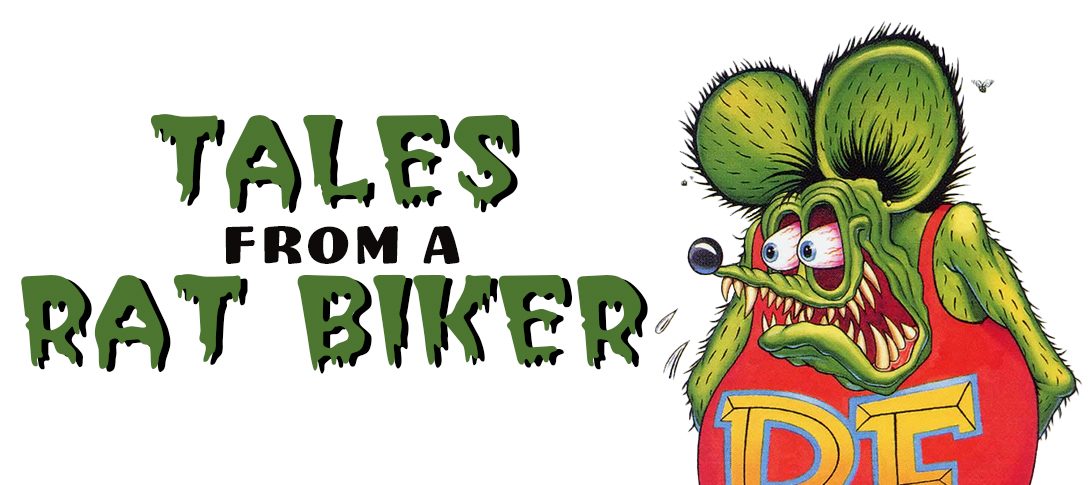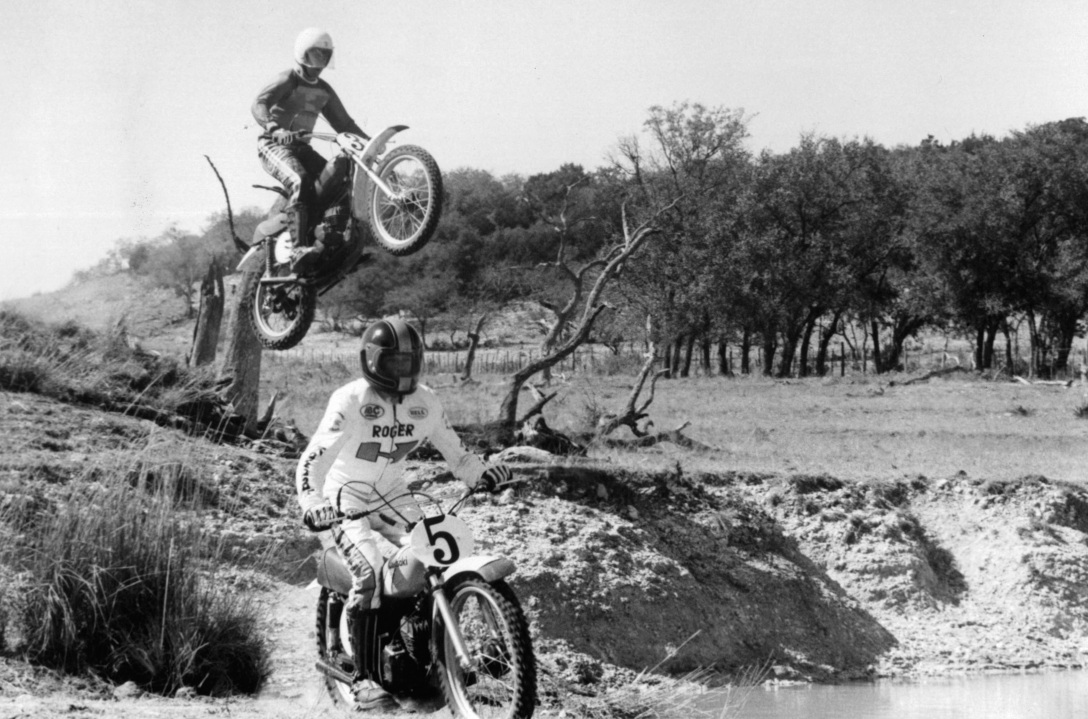Race with the Devil (1975) is one of the few occult biker movies. It therefore occupies a tight huddle with Werewolves on Wheels (1971), Psychomania (1973), and I Bought a Vampire Motorcycle (1990). It also reflects the early 1970s craze with the occult that followed movies like Rosemary’s Baby and The Exorcist, spawning a generation of middle-class suburban devil worshippers because that crowd will take any excuse to have an orgy. But I digress. Purists may argue that Race with the Devil is not a ‘biker movie’ as motorcycles only feature in two early scenes which are largely peripheral to the plot. That said, the protagonists are both bike riders, off-roaders, and motorcycle dealers, one of them being Peter Fonda so I rest my case.
These guys go back a long way. They are now both married and respectable business partners, but their longish hair, capacity for drink, and familiarity with firearms suggests something of a mis-spent youth, either in the military or on the edge of the outlaw scene, which is where all the non-franchised dealerships I know originated. When Warren Oates tells Fonda ‘We’ve come a long way in five years, brother,’ it’s tempting to think of Fonda in his Wild Angels/Easy Rider period and Oates in The Wild Bunch. I will concede, however, that I did spend about half the movie waiting for the Kawasaki 125 trials bikes strapped to the back of the heros’ RV to fire up again, until some satanists vandalised them beyond the capacity of even Warren Oates’ magical fingers. (In one scene, he makes a major repair on the RV engine in ‘about thirty minutes’, a timeframe that would make even Scotty from Star Trek think twice.)
San Antonio motorcycle dealers Roger Marsh (Fonda) and Frank Stewart (Oates) and their wives Kelly (Lara Parker, Angelique from Dark Shadows) and Alice (MASH’s Loretta Swit) are long overdue for a break. The plan is to travel across country in Frank’s all-mod-cons RV to Aspen, Colorado for a skiing holiday. On their first night under the stars, Roger and Frank spot what they assume is a bunch of hippies on the other side of a river dancing around a fire beneath a gnarled tree. Slightly pissed, the two friends creep closer to have a look and witness a masked man and a group of hooded figures apparently murder a naked girl in some sort of ritual sacrifice. Just then, Alice calls to them, alerting the cultists and triggering an intense chase in which a couple of burley devil worshippers manage to hang onto the RV long enough to smash the rear window before Roger fights them off with a ski pole.
Exhausted and traumatised, Frank drives to the nearest town and reports the murder to the local sheriff, Taylor, played with charming menace by Sam Peckinpah regular R.G. Armstrong. The sheriff and his deputy take Roger and Frank back to the scene of the crime, where a dead dog is discovered. Taylor tries to convince the friends that they must have seen the dog getting killed, but Roger is not persuaded. He secretly takes a sample of the blood-soaked sand with the intention of taking it to the police in Amarillo. Meanwhile, Alice and Kelly find a paper covered in weird symbols stuck on the broken glass of the rear window. Someone has cast the runes. The group get the RV patched up and attempt to get back on the road, their trip thereafter plagued by increasingly sinister interventions – phones always out of order, creepy locals, rattle snakes in the RV, Kelly’s dog killed – indicating that the satanists are after them. Events escalate until a climactic chase scene in which cultists in pickup trucks pursue the RV at high speed while Frank tries to fight them off with a shotgun. Predating The Road Warrior by seven years or so, director Jack Starrett uses the same device that George Miller would later refine in having the climax function like a kind of mobile siege, in which the attackers strip back defences before climbing the battlements as it were, jumping onto the RV and trying to get inside. The film ends shortly afterwards, with a typically abrupt 1970s nihilistic ending.
Race with the Devil shares its basic premise with new wave American horror films like The Texas Chainsaw Massacre and The Hills Have Eyes, in which decent, middle class townies venture into the middle of rural nowhere and get hunted and slaughtered by ritualistic killers and mutants. This was a trope much used by EC horror comics such as Tales from the Crypt in the early 1950s, particularly in the stories of Jack Davis (a native of Georgia), in which the countryside was populated almost entirely by atavistic cannibals and psychos. Roger, Frank and their wives don’t do anything to bring this horror down on themselves. They’re not being punished for immoral character flaws and are perfectly law-abiding. Their fate is as random as a ’gator attack. Like characters from a fairy tale, they blunder innocently into disaster because they did not understand the rules of the enchanted forest, and because they weren’t from around these parts. As Kevin Smith (whose film Red State was inspired by Race with the Devil) told Bloody Disgusting:
When I was a kid it was just such a terrifying notion. It’s where you’re on vacation and you just happen to see some mother fuckers sacrificing a virgin, they kill your dog, and the chase you in your Winnebago. There’s nothing more horrifying than that! You can keep your fucking thirty-foot shark, that’s terrifying!
The film also follows the logic of Rosemary’s Baby, in which everyone turns out to be part of the conspiracy, including director Jack Starrett, who is one of the homicidal truck drivers of the climax.
Like Fonda, Starrett was a veteran of low budget outlaw biker movies. He acted in The Born Losers and Hells Angels on Wheels in 1967, Angels from Hell (1968), and Hell’s Bloody Devils (1970), as well as directing Run Angel Run (1969) and The Losers (AKA Nam’s Angels, 1970). To most cinemagoers, he is probably most recognisable as Gabby Johnson in Blazing Saddles and the sadistic deputy Art Galt, who tortures Sylvester Stallone in the original First Blood. (He’s the one that falls out of the helicopter.) In Race with the Devil, Starrett’s direction has that loose, verité look in dialogue scenes that makes the film feel almost like a home movie (and which worked so well for Dennis Hopper in Easy Rider), switching to kinetic and intense action scenes on the road, a style honed in his biker movies, which are all about speed and movement. His follow-through the next year was A Small Town in Texas, a modern western which returned to the theme of corrupt smalltown law enforcement, ending with another grindhouse car chase. Starrett claimed at the time that he’d hired real satanists as extras, which seems unlikely but is a wonderful promotional quote. He died far too young in 1989 at the age of 52.
Race with the Devil was a 20th Century Fox production with a $1.7 budget and name actors. One gets the feeling, however, that director Starrett and screenwriters Wes Bishop and Lee Frost (the latter a veteran grindhouse director with credits that include infamous Nazisploitation movie Love Camp 7, Chain Gang Women, Chrome and Hot Leather, and The Thing with Two Heads), were a little out of their comfort zone. The film therefore often feels underwritten, with little character development, suspense or, indeed, action. Everything’s invested in that final chase. This is, admittedly, awesome, but it doesn’t carry the entire movie. But then, as I said, how many occult motorcycle movies are there? On this one, we have to give the devil his due.


